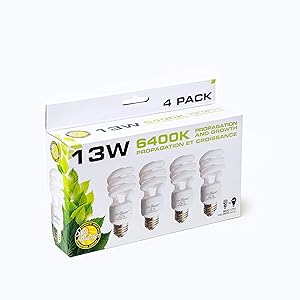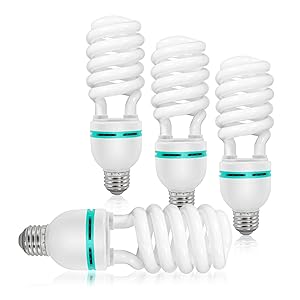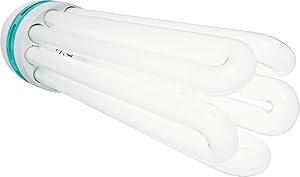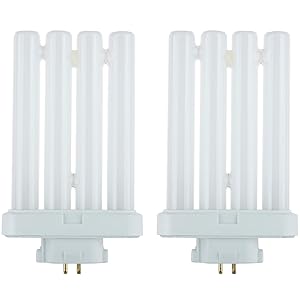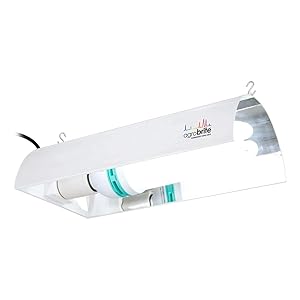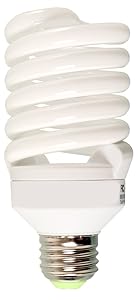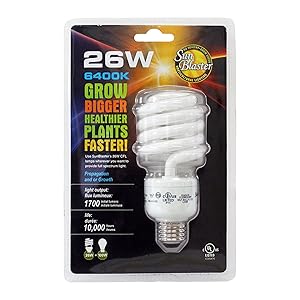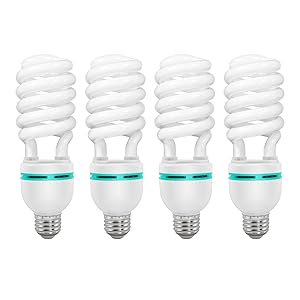CFL grow lights are commonly used for indoor gardening to provide the necessary light spectrum for plant growth. They are suitable for starting seeds, cuttings, and the early vegetative stage but may not be as effective for large plants and the flowering stage. CFL grow lights offer benefits such as ease of use, availability, low heat emission, and energy efficiency.
When choosing the best CFL grow light, important considerations include the wattage, color temperature, coverage area, and certifications like Energy Star and UL.
Regarding CFL grow lights, choosing fixtures over individual bulbs is generally better. Fixtures provide a complete lighting solution with multiple bulbs, ensuring better light distribution, coverage, and uniformity throughout your indoor garden.
The specific features needed for CFL grow lights depend on the plants being grown, such as seedlings, microgreens, or cannabis. Prioritizing lights with a high color temperature (5000K-6500K) to mimic natural sunlight and adjust bright light levels to accommodate different growth stages is best. Additionally, select lights with a wide beam angle to ensure sufficient light coverage and distribution for optimal plant development.
Listed below are the top selection lists of CFL grow lights for all types of indoor growing in 2024:
- Best CFL grow bulbs: The best CFL grow bulbs are the SunBlaster Self-Ballasted Light Bulb. With its energy efficiency, full spectrum of light, and manageable wattage of 26.00, these bulbs hold great potential as a lighting solution for growing plants indoors.
- Best CFL grow light for seedlings: The best CFL light for seedlings is the Hydrofarm AgroBrite CFL Light, which has a 6,500 K for optimal indoor growth.
- Best CFL grow lights for cannabis: The best CFL for cannabis growth is the Photo Light Bulb CFL Grow Lights. The lights offer a full spectrum of light penetrating the buds under the canopy.
Table of Contents
- 1. SunBlaster Grow Lamp – Best CFL grow lights
- 2. LimoStudio Photo Light Bulb CFL Grow Lights – Best for growing cannabis
- 3. Hydrofarm AgroBrite CFL Light – Best CFL for seedlings
- 4. SLOW DOLPHIN Photography Bulbs – Best broad coverage
- 5. Sunlite Quad Tube Plug-in Compact Fluorescent Lamp – Best plug-in CFL light
- 6. Hydrofarm Agrobrite Compact Fluorescent System – Best for larger grow setup rooms
- 7. SLEEKLIGHTING 13 Watt Blue Spiral CFL – Best blue light CFL
- 8. Agrobrite FLC26D 26-Watt Spiral – Best efficient and versatile CFLs
- 9. SunBlaster Self-Ballasted Light Bulb – Best full spectrum light
- 10. LimoStudio CFL 45 Watt – Best budget pick
- How Do You Choose the Best CFL Grow Light?
1. SunBlaster Grow Lamp – Best CFL grow lights
| Light type | CFL |
|---|---|
| Wattage | 13 Watts |
| Light Color | White |
| Voltage | 120 v |
| Number of Items | 1 |
| Shape | Tubular(T) |
| Material | Glass |
| Product Dimensions | 9.5 x 11 x 2 inches |
| Unique Characteristics | Energy Efficient |
The SunBlaster CFL self-ballasted lamps offer a practical solution for various indoor growing applications, such as growing microgreens or flowers. These affordable lamps are an ideal choice for cost-effective lighting solutions.
This pack includes four lamps, offering extensive coverage for indoor gardens of various sizes, from compact green salad gardens to vertical wall gardens. Moreover, the lifespan of these lamps is 10,000 hours on average.
These CFL lamps feature an easy installation into standard-size light sockets. The wattage options range from 13 to 55 Watts, while higher wattage options require a mogul socket.
The SunBlaster compact fluorescent lamps provide a 6400K spectrum, making them perfect for all stages of plant growth indoors.
Compared to other options on the market, the CFL lamps deliver high-quality results at an affordable price. We rated the SunBlaster CFL self-ballasted lamps at 4.5/5 due to the high-quality results of these lamps for indoor plant growth.
Pros: The 6400K spectrum is ideal for various stages of plant growth.
Cons: Multiple lamps might be needed to cover a larger space adequately.
2. LimoStudio Photo Light Bulb CFL Grow Lights – Best for growing cannabis
| Light type | CFL |
|---|---|
| Spiral | 45 watts |
| Light Color | Pure white light |
| Voltage | 120 V |
| Number of Items | 4 |
| Shape | Sprial |
| Material | Glass |
| Product Dimensions | 9.3 x 9.1 x 11.1 inches |
| Unique Characteristics | Full Spectrum |
The LimoStudio Photo Light Bulb emits a 6500K spectrum that closely resembles natural daylight. The blue wavelengths in the pure white light emitted by these bulbs promote vegetative growth and help plants develop strong stems, leaves, and roots.
The LimoStudio Photo Light bulbs offer a good balance between light intensity and energy efficiency, thus consuming less energy than traditional incandescent bulbs. The bulbs can be easily installed in standard light fixtures.
However, the 45-watt CFL bulbs might not be suitable for larger plant setups or plants with higher light requirements during flowering and fruiting stages. The average price of the LimoStudio Photo Light bulbs is affordable. We rated it at 4/5 due to the daylight-balanced light and the energy-efficient CFL technology.
Pros: Emitting blue wavelengths stimulates leafy growth and the flowering phase.
Cons: This may not provide sufficient light intensity for the flowering and fruiting stage.
3. Hydrofarm AgroBrite CFL Light – Best CFL for seedlings
| Light type | CFl |
|---|---|
| Wattage | 125 W |
| Light Color | Cool White |
| Voltage | 120 V |
| Number of Items | 1 |
| Shape | Reflector(R) |
| Material | Glass |
| Product Dimensions | 4 x 4 x 15.04 inches |
| Unique Characteristics | Does not cause heat stress |
The Hydrofarm CFL grow light is a versatile option for individuals seeking effective lighting, offering energy efficiency, low heat emission, and ease of use. Its cool (6500K) color spectrum provides tailored lighting for vegetative growth.
The Hydrofarm CFL light is highly regarded for its blue-rich spectrum that promotes vegetative growth and its light output of 125 watts, which can potentially improve yields. It also emits minimal heat, making it safe for close placement to plants.
The self-ballasted design and compatibility with CFL reflectors make installation straightforward and flexible. The small dimensions of the bulb and efficient heat dissipation generated during operation prevent excessive space consumption and reduce the risk of overheating plants.
Overall, the 45-watt CFL grow light offers a versatile solution for indoor gardeners. We rated the Hydrofarm CFL light at 4/5 stars due to its effective illumination for indoor gardening.
Pros: Does not cause heat stress to the plants.
Cons: Limited coverage area.
4. SLOW DOLPHIN Photography Bulbs – Best broad coverage
| Light type | CFL |
|---|---|
| Wattage | 105W |
| Light Color | Daylight white |
| Voltage | 5500K |
| Number of Items | 3 |
| Shape | Tubular(T) |
| Material | Glass |
| Product Dimensions | 11 x 3 x 9 inches |
| Unique Characteristics | Covers a broad area |
The SLOW DOLPHIN CFL lights offer a wattage of 105W and a color temperature of 5500K, suitable for both vegetative growth and flowering stages.
The Slow Dolphin CFL bulb is energy-efficient, saving up to 80% conservation when compared to traditional bulbs.
Notably, the 105-watt output is equivalent to that of a 500-watt incandescent light bulb, providing ample brightness without excessive power consumption. With a lifespan exceeding 8000 hours, this bulb offers long-lasting performance.
This high-wattage light bulb suits larger indoor gardening setups like grow tents. However, the 5500K color temperature may not be enough for tropical plants or orchids.
We rated the Slow Dolphin lights at 4.5/5 stars. While some customers are satisfied with the quality of these bulbs, others are still looking for their longevity.
Pros: Offers a broad coverage area for larger plants.
Cons: Low light intensity for tropical plants.
5. Sunlite Quad Tube Plug-in Compact Fluorescent Lamp – Best plug-in CFL light
| Light type | CFL |
|---|---|
| Wattage | 27W |
| Light Color | Daylight white |
| Voltage | 120V |
| Number of Items | 1 |
| Shape | Tubular(T) |
| Material | Glass |
| Product Dimensions | 3.25 x 0.9 x 5.75 inches |
| Unique Characteristics | Plug-in design |
The Sunlite Quad CFL grow light bulbs are best known for their light output, color accuracy, longevity, and specific compatibility.
It has a light output of 1500 lumens and boasts an 80 CRI, ensuring that colors appear natural and vibrant.
The long lifespan of 10,000 hours reduces the frequency of replacements and potentially saves on costs over time.
The 6500K color temperature provides a daylight-like illumination, promoting healthy indoor garden plant growth.
This bulb is designed for a GX10Q-4 socket, so it’s necessary to ensure proper compatibility with your fixture and external ballast.
We rated it at 4.5/5 stars due to the light’s longevity and effectiveness. The light is available in daylight and warm white light so that customers can choose their preference.
Pros: The 6500K color temperature closely mimics natural daylight.
Cons: Requires compatibility with special fixtures.
6. Hydrofarm Agrobrite Compact Fluorescent System – Best for larger grow setup rooms
| Light type | CFL |
|---|---|
| Wattage | 125W |
| Light Color | Daylight white |
| Voltage | 120V |
| Number of Items | 1 |
| Shape | Reflector(R) |
| Material | Man-made-material |
| Product Dimensions | 18 x 12 x 8.5 inches |
| Unique Characteristics | The system can support larger growing plants |
The Hydrofarm FLCDG125D Fluorowing Compact Fluorescent System offers an all-in-one design, reflector efficiency, and versatile lighting options for an indoor garden.
The Hydrofarm light comes with a reflector, a 125-watt CFL bulb, a mogul socket, and an 8-foot power cord, all suited for illuminating plants during the vegetative stage.
The Hydrofarm FLCDG125D Fluorowing Compact Fluorescent System provides a balanced wattage and light output for optimal plant growth, and it’s compatible with a 200-watt CFL bulb. The integrated reflector distributes light efficiently and uniformly, preventing uneven growth.
Although the system includes CFL bulbs, it’s worth mentioning that they have a fixed color temperature limiting customization. Some customers have expressed satisfaction with the overall quality of the light kit, while others are dissatisfied with its longevity.
We rated this Hydrofarm Agrobrite system lighting system at 4/5 stars.
Pros: Easy to use.
Cons: The CFL lacks customization.
7. SLEEKLIGHTING 13 Watt Blue Spiral CFL – Best blue light CFL
| Light type | CFL |
|---|---|
| Wattage | 13W |
| Light Color | Blue |
| Voltage | 120V |
| Number of Items | 4 |
| Shape | Arbitrary |
| Material | Glass |
| Product Dimensions | 2.5 x 2.5 x 4 inches |
| Unique Characteristics | Emits blue light |
The Sleeklighting CFL light is a top-notch choice for indoor plant growing. With its energy-efficient 13-watt wattage, it consumes less electricity compared to traditional bulbs.
The CFL grow light emits a balanced light spectrum, including blue and red wavelengths. Its compact T2 bulb shape makes it easy to place in tight spaces and is ideal for small areas.
The limited coverage area is due to the light’s compact size and lower wattage, so it may not be suitable for larger areas such as 4×4 grow tents.
The Sleeklighting provides the necessary light spectrum while minimizing heat emission, ensuring optimal plant health.
We rated it at 4.5/5 stars, mainly because customers are satisfied with this product.
Pros: Compact design, suitable for small indoor gardens.
Cons: Limited coverage area.
8. Agrobrite FLC26D 26-Watt Spiral – Best efficient and versatile CFLs
| Light type | CFL |
|---|---|
| Wattage | 26W |
| Light Color | Cool white |
| Voltage | 120V |
| Number of Items | 1 |
| Shape | Spira |
| Material | Glass |
| Product Dimensions | 2.5 x 2.63 x 5.75 inches |
| Unique Characteristics | Energy-efficient |
The Agrobrite Compact Fluorescent Spiral Grow Lamps are energy-efficient lighting solutions you will need if you want to lower energy costs!
Compatible with Dayspot grow light fixtures and standard light fixtures featuring a medium (E26) base, these lamps are available in two models: the FLC26D with 26 watts and the FLC32D with 32 watts, both with a color temperature of 6400K.
The CFL lamps offer a balanced light spectrum suitable for both vegetative and flowering stages. The lights are ideal for houseplants and small seedlings.
The FLC26D emits 1600 lumens and the FLC32D emits 1800 lumens, both with an expected life service of 10,000 hours, providing long-term consistent performance.
We rated the Agrobrite lamp at 4/5 stars due to Agrobrite’s energy efficiency and balanced spectrum.
Pros: Versatile for not just plant growing but for other home uses as well.
Cons: Limited coverage area.
9. SunBlaster Self-Ballasted Light Bulb – Best full spectrum light
| Light type | CFL |
|---|---|
| Wattage | 26W |
| Light Color | White |
| Voltage | Not specified |
| Number of Items | 1 |
| Shape | Rectangle |
| Material | Glass |
| Product Dimensions | Not specified |
| Unique Characteristics | Full Spectrum Lights |
The Energy-Efficient Full Spectrum CFL Grow Lamp Light Bulbs are a promising lighting solution for indoor plant cultivation, utilizing compact fluorescent technology to minimize energy consumption and promote sustainability.
Its full light spectrum covers different growth stages, ensuring optimal plant development. The 26.00-watt light bulbs suit indoor vegetable, herb, flower, and small-scale hydroponic systems.
However, it’s worth noting that the coverage area may be limited, making it less suitable for larger gardens or dense plant canopies. Customers are pleased with the versatility of this product, but a few are disappointed with its longevity.
We rated the SunBlaster self-ballasted bulb at 4/5 stars.
Pros: The lamp emits a full spectrum of light that caters to all growth stages.
Cons: The coverage area of this CFL grow lamp may be limited.
10. LimoStudio CFL 45 Watt – Best budget pick
| Light type | CFL |
|---|---|
| Wattage | 45W |
| Light Color | Daylight white |
| Voltage | 120V |
| Number of Items | 4 |
| Shape | Spiral |
| Material | Glass |
| Product Dimensions | 6.9 x 6.4 x 8.8 inches |
| Unique Characteristics | Budget-friendly price |
The LimoStudio Full Spectrum Light Bulb has excellent energy efficiency, versatile application, and full spectrum coverage.
This LimoStudio 45W CFL light bulb emits 2100 lumens of visible light, providing sufficient intensity in low-light environments. Its full light spectrum covers essential wavelengths for different growth stages, supporting optimal plant development.
The 6500K daylight color temperature of LimoStudio bulbs mimics natural sunlight, aiding photosynthesis. However, their light intensity is lower than higher-powered options like Hydrofarm Agrobrite Compact Fluorescent System, resulting in slower growth for light-demanding plants.
These bulbs are cost-effective for indoor gardening enthusiasts seeking robust plant development.
We rated this LimoStudio CFL light at 4.5/5 stars. It is budget-friendly.
Pros: The 45W energy output is easily adapted to vegetative, flowering, and fruiting stages.
Cons: The coverage area of this compact fluorescent light may be limited.
How Do You Choose the Best CFL Grow Light?
When choosing the best CFL grow lights, the factors to consider are wattage, lumens, color & temperature, plant space and coverage area, energy efficiency, indoor or outdoor use standards, and certification.
The Wattage of the CFL: Compact fluorescent bulbs come in various wattages, with the top 5 common ranges being 5-7 watts, 9-13 watts, 14-20 watts, 23-30 watts, and 40 watts or higher.
For vegetative phase plants that require moderate to high light, 9-13 watt CFL bulbs are recommended as they provide adequate light for foliage growth without excessive energy consumption.
During flowering, plants benefit from stronger light, so 14-20 or 23-30 watt CFL bulbs should be used to support blossoming. However, it’s important to ensure proper ventilation and cooling as higher-wattage bulbs emit more heat and can potentially harm the plants.
Lumens: CFL lumens measure the light output of a CFL bulb, with variations based on wattage and brand. The top 5 common lumen ranges for CFL bulbs are 200-400 lumens for 5-6 watt bulbs, 450-800 lumens for 8-12 watt bulbs, 900-1,100 lumens for 13-15 watt bulbs, 1,200-1,500 lumens for 18-20 watt bulbs, and 1,600-2,600 lumens for 23-30 watt bulbs.
Vegetative plants benefit from CFL lights with 900-1,500 lumens for leaf development, while a higher lumen output of 1,600 lumens or more is ideal during flowering.
Consider the appropriate lumen output for your plants’ growth stage when purchasing CFL bulbs for indoor cultivation.
Color and Temperature: CFL grow lights are available in warm white, cool white, and daylight/full spectrum variations, each suitable for different plant growth stages.
The vegetative phase benefits from 6500K blue spectrum light while flowering plants need a balanced spectrum, including red and orange light.
Instead of buying lights of different hues and temperatures and adjusting them as the plant grows, a mix of warm white (2700K) and cool white (6500K) CFL lights or full spectrum lights can provide a balanced spectrum throughout the plant’s lifespan. This allows the right light spectrum to support plant development without frequent replacements.
Plant Space and Coverage Area: Plant spacing and coverage area are important considerations when purchasing CFL lights.
High-light plants, such as cannabis, require around 60 to 100 watts per square foot, while low-light plants need 10 to 15 watts per square foot of fluorescent light.
To determine the number of CFL lights needed, divide the total wattage required by the wattage of each CFL bulb. For example, if you need 20 watts and have CFL bulbs with an average wattage of 14 watts, you would need approximately 1.43 CFL lights. However, these calculations are general guidelines, and adjustments may be necessary based on the specific light requirements of the plants being grown.
Energy Efficiency: Energy-efficient lights save power and emit less heat, minimizing the need for cooling in your growing environment.
Check the energy efficiency rating or the energy consumption value when buying CFLs. This rating is commonly shown as Energy Star for appliances or an A-G energy rating scale. The energy-efficient product has a higher rating or is closer to A.
Compare energy efficiency ratings to choose the most energy-efficient CFL. The energy-efficient one has a higher rating or lower energy usage.
Indoor/Outdoor CFL: When determining the suitability of a product for indoor or outdoor use, there are several indicators to consider.
These include the IP rating, which signifies the level of protection against solids and liquids, with higher second digits indicating greater water resistance and thus making a product more suitable for outdoor use.
UL Listing certifications, such as “Suitable for Wet Locations,” indicate whether a product is designed for outdoor use. The construction and materials used in the product, along with clear labeling and manufacturer recommendations, also provide valuable insights into its intended application environment.
Certification: Certification is important to ensure that CFL lights meet safety and performance standards.
Recommended certifications for CFL lights include Energy Star, UL, and FCC Compliance.
Energy Star certification ensures that the CFL lights meet strict energy efficiency standards the EPA and DOE set, reducing energy consumption and lowering power expenses.
UL certification indicates that the CFL lights have undergone thorough testing to meet safety and performance requirements.
FCC Compliance certification ensures that the CFL lights do not interfere with radio transmissions or other electronic devices.
While all certifications are significant, Energy Star and UL certifications are particularly critical as they guarantee energy efficiency, safety, and performance.
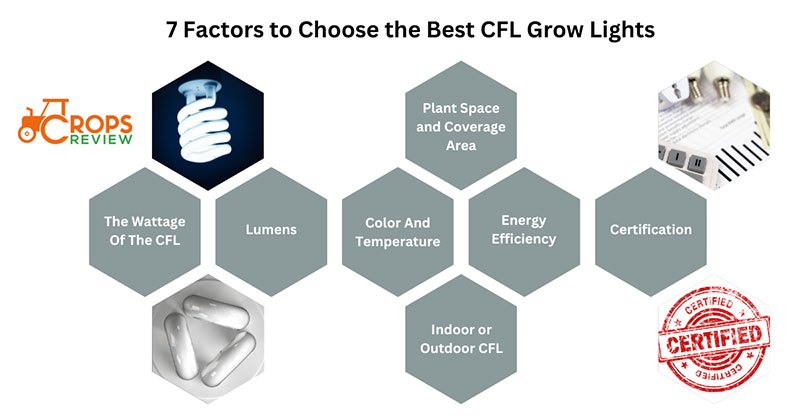
What types of CFLs are there?
CFLs are categorized into three main types based on their color temperature: soft white, cool white, and daylight.
Finding the perfect balance between warm and daylight light bulbs is key for proper plant growth. If growers focus solely on one light over the other, they can risk creating an imbalance in the plant’s flowering, fruiting, and vegetative stages.
Daylight (5000K-6500K): CFL Daylight has a color temperature ranging from 5000 to 6500 Kelvin (K). The blue spectrum helps promote vegetative growth, root development, plant structure, and early plant development.
Cool White, Bright White (3500-4100K): Cool white, brilliant white CFLs have a 3500–4100 Kelvin color temperature. The cold white light encourages chlorophyll synthesis, vegetative development, and plant structure.
Warm White, Soft White (2700-3000K): Warm, soft white has a color temperature between 2700 and 3000 Kelvin (K). They generate a warm, yellowish light like incandescent bulbs and create a lot of orange and red wavelengths. Soft white light provides the right spectrum for plant growth at various stages and encourages blooming, fruiting, and plant growth.
What are the best CFL grow bulbs?
The best CFL grow bulbs emit appropriate color temperatures for different stages of plant growth, generate minimal heat, and are energy-efficient.
SunBlaster self-ballasted CFL bulbs are considered the best CFL grow bulbs for indoor plant cultivation due to their full spectrum lighting, energy efficiency, versatility, easy installation, and long lifespan. These best CFL bulbs replicate natural sunlight, providing the necessary light spectrum for healthy plant growth.
What is the best CFL grow light for seedlings?
The best CFL light for seedlings should meet specific requirements to ensure proper growth. It is recommended to start with at least two 40W CFL bulbs or a total of 80 watts per plant, increasing as the plants grow. The bulbs should have a color temperature of around 5000K to 6500K, providing a “daylight” spectrum suitable for vegetative growth.
The best low-heat choice is the Hydrofarm Agrobite CFL. The light it emits, which is rich in the blue spectrum, is ideal for promoting vegetative growth and supplying the required light energy for optimal progress during these stages. The light produces little heat and enough light intensity, permitting it to be positioned close to plants without inducing heat-related stress.
What are the best CFL grow lights for cannabis?
The best CFL light for cannabis requires bulbs with a daylight color temperature of at least 5500K for vegetative growth and additional “soft white” bulbs for flowering. Providing a minimum of 60 watts per square foot and maintaining the appropriate distance between the bulbs and foliage ensures optimal light absorption.
The PhotoLight bulb is the best CFL grow light for cannabis. This specific color temperature of this cannabis grow light closely replicates the natural illumination of daylight, rendering it a suitable option for cultivating indoor plants and reaching the buds under the canopy.
Can I use regular CFL bulbs to grow plants?
Yes, you can use regular CFL bulbs for growing plants. However, there are some factors to consider. Regular CFL bulbs emit a broad spectrum of light, including warm and cool lighting tones, which can benefit plants during their different growth stages. However, they may not provide the optimal light intensity and spectrum required for vigorous growth.
Regular CFL bulbs may require careful placement, quantity, and duration adjustment to provide adequate light coverage. For more successful and efficient plant growth, especially with various plants or higher-yield expectations such as succulents or herbs, using CFL grow lights like SunBlaster Grow lamp specifically designed for plant cultivation is recommended.
Can I use CFL for flowering?
Yes, CFL grow lights can be used for the flowering stage of plants by choosing warm white bulbs with color temperatures around 2700K-3000K, which provide the necessary red spectrum for flower and fruit development.
However, due to potentially lower light intensity than other lighting options, it’s important to position the CFL bulbs appropriately to maintain adequate light coverage and intensity across the flowering canopy.
Depending on the size of your flowering area, using multiple CFL bulbs might be necessary. To achieve optimal flowering outcomes, consider supplementing CFL lighting with additional light sources like LED or HID grow lights for larger spaces or light-demanding plants.
Where to place your CFLs?
Place your CFL grow lights near your plants, keeping them 2-6 inches (5-15 cm) from seedlings and young plants and 6-12 inches (15-30 cm) from mature ones while angling the bulbs to evenly cover the plant canopy.
Space the bulbs for uniform coverage and rotate plants to prevent leaning if you are using multiple bulbs. Secure adjustable fixtures to maintain the optimal distance from plants, choose overhead or side lighting based on plant characteristics, monitor plant response, and maintain consistent placement throughout growth stages for even and effective light distribution.

